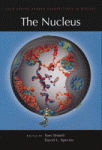Book review: A wake-up call to delve deeper into the cell
Posted by Development Book Reviews, on 5 January 2012
This book review originally appeared in Development. Wendy Bickmore reviews “The Nucleus” (Edited by Tom Misteli and David L. Spector).
Book info:
The Nucleus Edited by Tom Misteli, David L. Spector Cold Spring Harbor Laboratory Press (2011) 517 pages ISBN 978-0-879698-94-2 $135 (hardback)
 Why should a developmental biologist be interested in a book about the nucleus? Almost 80 years ago, Conrad Waddington put forward ideas about how gene products could regulate development. In modern parlance, much of development is the result of the differential use of the same genome in different cell types and at different developmental stages within the same organism. This originates in the nucleus, where the processes that act upon the genome – transcription, replication, repair – occur. In developmental biology papers it is not uncommon to find a final summary figure in which a signaling pathway ends up pointing into an oval-shaped nucleus, devoid of any structure or organization, save for a linear depiction of a target gene locus. However, the nucleus is not a homogenous space and neither is the genome in its natural nuclear environment arranged in a linear fashion.
Why should a developmental biologist be interested in a book about the nucleus? Almost 80 years ago, Conrad Waddington put forward ideas about how gene products could regulate development. In modern parlance, much of development is the result of the differential use of the same genome in different cell types and at different developmental stages within the same organism. This originates in the nucleus, where the processes that act upon the genome – transcription, replication, repair – occur. In developmental biology papers it is not uncommon to find a final summary figure in which a signaling pathway ends up pointing into an oval-shaped nucleus, devoid of any structure or organization, save for a linear depiction of a target gene locus. However, the nucleus is not a homogenous space and neither is the genome in its natural nuclear environment arranged in a linear fashion.
The contributions in this book, from international leaders in the field of nuclear organization and function, are based upon the premise that we cannot really understand how genomes function without an appreciation and understanding of their natural cellular environment – the nucleus.
The 28 chapters are organized to provide a comprehensive overview of nuclear compartments and their components (e.g. nuclear membrane, nuclear pore complex, chromosome territories, Cajal body, nucleolus), to discuss how this organization relates to function (transcription, DNA replication and repair, RNA processing) and to describe the defects in nuclear organization in human disease. The focus is primarily on the nucleus in mammalian cells, but there are also discussions on other simpler model organisms – budding yeast, Caenorhabditis elegans and Drosophila. Each chapter is relatively short and accessible, making this a great resource to dip into. Illustrations are used sparingly but are well chosen.
The main target audience for this book is likely to be teachers and students of cell biology. The most interest for developmental biologists will lie in those chapters that deal with the organization of the genome and the transcriptional machinery within the nucleus. Spatial and temporal changes in genome organization are increasingly recognized as important aspects of gene regulation, especially in stem cells and differentiation. Thus, from a developmental biologist’s perspective, it is disappointing that no specific chapter is dedicated to the nucleus in development, but there are nuggets of relevant information within most chapters. The chapter on dosage compensation (written by Jennifer Chow and Edith Heard) is of direct relevance to events that occur in early embryogenesis, and a chapter on Lamin-binding proteins (written by Katherine Wilson and Roland Foisner) emphasizes the fact that proteins of the nuclear periphery that link the nucleus to the cytoskeleton are particularly important in regulating the position of the nucleus in specific cell-types or tissues (e.g. retina and neurons) and in relaying signals from the cytoplasm to the nucleus.
Developmental biologists often ask where and when a gene or protein is expressed in the developing organism. However, rarely do they ask precisely where within the cell a particular protein is located. There are several examples of proteins that are expressed within a particular cell type, but are sequestered into a nuclear compartment that renders them functionally inactive. Thoru Pederson gives a fascinating example of this (sequestration of the Hand1 transcription factor into the nucleolus of trophoblasts) in his chapter on the nucleolus. This should be a wake-up call for developmental biologists to delve deeper into subcellular organization. Conversely, most cell biology of the nucleus is still studied in cell lines rather than in real biological organisms or embryos. There is clearly scope to bridge these two disciplines. Indeed, in their chapter on Chromosome Territories, Thomas and Marion Cremer provide a superb example of the benefits that can come from considering nuclear organization in a developmental setting. They describe the amazing nuclear reorganization of the genome that occurs, after birth, in the rod cells of nocturnal mammals and they emphasize how such a fundamental aspect of nuclear organization can be turned on its head in the face of selection pressure – in this case, to facilitate the passage of photons to photoreceptors in low light levels.
There are other equally fascinating examples to be found in this book where nuclear organization impinges directly on developmental processes. Nuclear condensation in terminally differentiated cells and aberrant nuclear organization in cancer are just two examples that come immediately to mind. So, although not targeted at developmental biologists, if your interest in the nucleus is piqued, then this book is a good place to start.


 (6 votes)
(6 votes)
now the reseach about the nucleus boom fastly,there is a hope to find more and more relative to genetic and epigenetic.all the questions are about how a gene in tne nelues is repressed or activated and how it transcript and translation